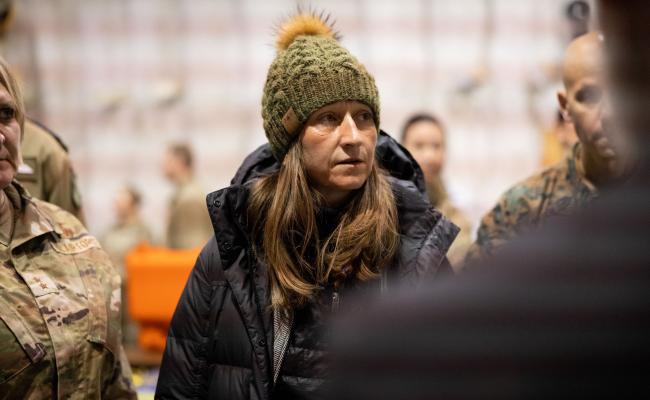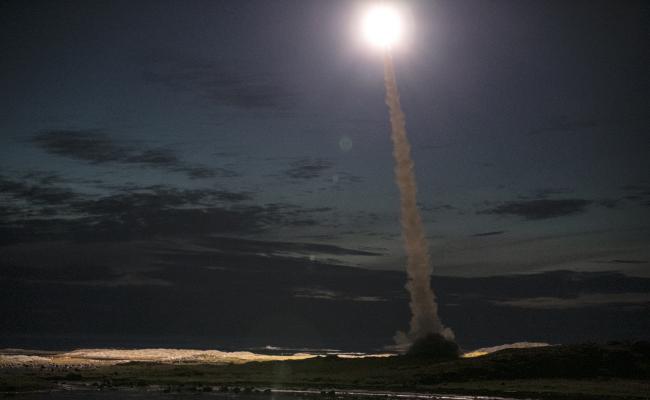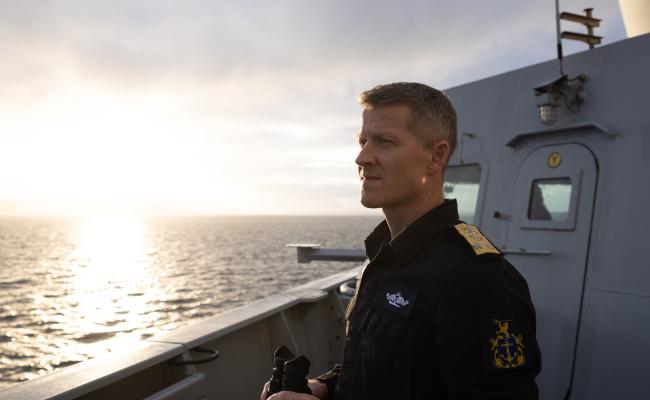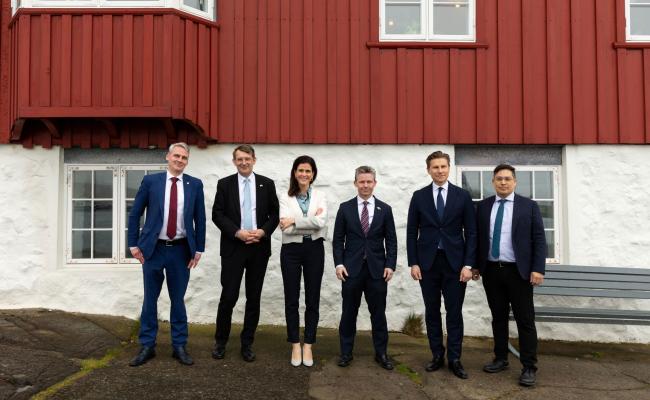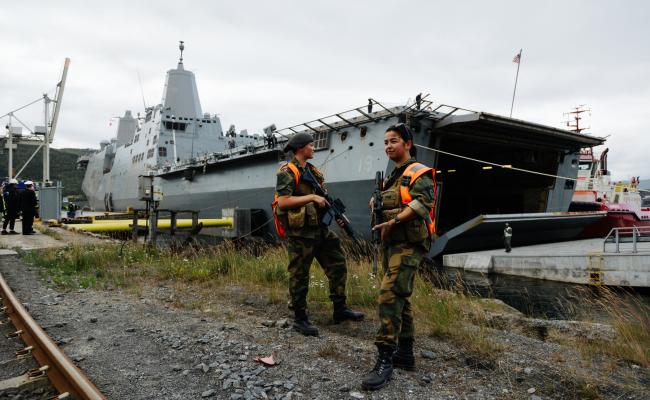Norway’s Parliament Agrees to Give the US Access to New Military Areas in the North
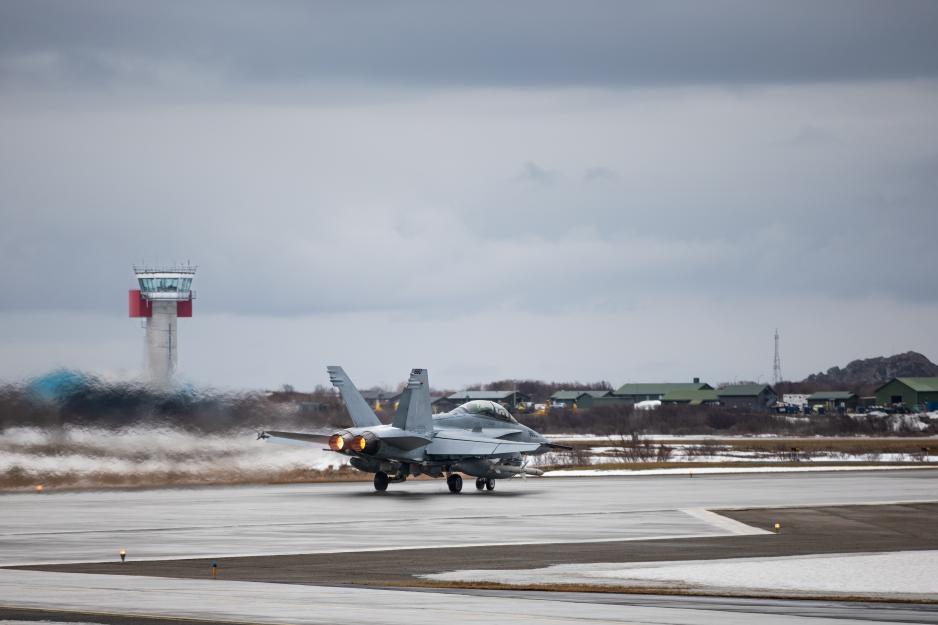
Andøya Air Station in Vesterålen has been launched as one of several new Norwegian-American agreed areas in Northern Norway. Such an arrangement is supported by Andøy municipality and the Norwegian parliament. Here, an American F/A-18 Hornet fighter takes off at this air station during the exercise Nordic Response in March 2024. (Photo: Ella Hagen/the Norwegian Armed Forces)
On Thursday, the Norwegian parliament voted in favor of giving US forces unimpeded access to several additional military areas, not least in the North. Norway should keep up with Sweden and Finland, recommended the Norwegian Intelligence Service – while others express concern for the policy that aims for low tension in the High North.
In February, Norway and the US signed an amendment agreement under the Supplementary Defense Cooperation Agreement (SDCA) to establish eight additional agreed areas on Norwegian soil.
In Northern Norway, these areas are Andøya and Bardufoss air stations, Setermoen garrison (including the firing and exercise range), and the Osmarka mountain facility in Evenes municipality.
On Thursday, the Norwegian parliament ratified the amendment agreement with 85 votes in favor – from the Labor, Conservative, Centre, Progress, Liberal, Green, and Christian Democratic parties.
Thus, the outcome became what the majority of the Standing Committee on Foreign Affairs and Defense recommended. The Socialist Left and the Red Party were the only parties to vote against, with 12 votes.
In the following, High North News presents the agreement's Nordic context, as well as excerpts from the government's consultation process and the recommendation of the aforementioned committee.
ALSO READ (THE ARTICLE CONTINUES BELOW)
Nordic context
Norway's SDCA with the US was signed in April 2021 and ratified by the Norwegian parliament in June 2022.
In this winter's updated edition, only Appendix A has been changed to include new agreed areas – from four to twelve.
The update followed Sweden, Finland, and Denmark's signing of bilateral defense agreements (DCAs) with the US in December.
These correspond to the Norwegian-American agreement of 2022 but open up far more agreed areas: 17 in Sweden (of which four are in the North), 15 in Finland (of which five are in the North), and three in Denmark (none in Greenland or the Faroe Islands).
"This has contributed to making it relevant to consider the establishment of new agreed areas in Norway beyond the existing four," wrote the Norwegian Ministry of Defense in the note that presents the amendment agreement for consultation.
In Sweden, the Committee on Defense and Foreign Affairs will present its recommendation on the government’s DCA bill on June 11th, and the parliament will vote on the matter on June 18th.
The Finnish government submitted to parliament its proposal on the DCA on Thursday.
Use and exercise of authority
In the agreed areas, the USA will be able to exercise and train, deploy forces, and store materiel – jointly with Norway (or the other respective countries) as well as other allies. American forces can also gain exclusive access and right of use to parts of these areas by special agreement.
Within and in the immediate proximity of agreed areas, American forces can exercise authority over citizens of the country in question for security reasons. In extraordinary cases, this also applies beyond such areas.
“Power can thus be exerted by any American troop member towards Norwegian civilians to restore order or protect the force," wrote the Judge Advocate General.
It is also central to the agreement that the US is given the first right to prosecute American soldiers who have committed criminal offenses outside of duty.
The Norwegian sense of justice may be particularly challenged if the prosecution of serious offenses against Norwegian citizens is to take place in the USA, the Director of Public Prosecution pointed out. In this year’s consultation process, the DPP refers back to his previous comments.
On the need for new agreed areas
The Norwegian Ministry of Defense (MoD) presented the amendment agreement under the SDCA for consultation on February 21st, with a deadline for submission of input March 13th. In other words, the consultation bodies and other stakeholders had less than a month to submit their observations.
In the consultation note, the ministry writes, among other things, the following about the need for more agreed areas on Norwegian soil:
"Strategic and operational cooperation with the USA will continue to be crucial for the defense of Norway. The USA and Norway have a common interest in free movement in the North Atlantic and cooperation on the allied strengthening of the Nordic region in line with NATO's planning. This is mutually beneficial for all allies."
Also read (the article continues below)
(Un)predictability
The MoD further points out that European allies have an interest in Norway facilitating the US's military contribution to Europe's security through "planned and predictable arrangements for reception and presence."
"Through bilateral agreements [such as SDCA, journ. note] the US gets an updated framework for military activity with allies and other friendly countries. This helps to create a long-term perspective in the relationship between the host countries and the United States, and also leads to greater predictability in American behavior in our part of the world," the ministry writes.
At the same time, such agreements can also facilitate an unpredictable American presence in light of the US's concurrency problem and defense doctrine, as High North News has previously reported. A possible new period with Donald Trump as US president will likely also be unpredictable.
Also read (the article continues below)
Investments in infrastructure
Furthermore, the MoD points out that the US Congress, within the framework of the European Deterrence Initiative, is prepared to make significant investments in infrastructure in agreed areas with allies, as is planned at Rygge Air Base in Southern Norway.
This spring, Norway and the USA also announced they will collaborate to build a temporary satellite station at the Andøya air base for early missile warning.
Relevant in this context is that the SDCA between Norway and the USA came about on American initiative, and the USA set the agreement as an "absolute requirement" for making new infrastructure investments on Norwegian soil.
ALSO READ (THE ARTICLE CONTINUES BELOW)
Demanding balancing act
"The establishment of agreed areas is one of our national measures to facilitate the further development of defense cooperation with the USA," writes MoD and continues:
"The approach is considered to be mutually beneficial for both parties over time and regardless of what the security policy situation is at different times. At the same time, geopolitical developments and the current demanding security situation in Europe contribute to underline the importance of both the SDCA and the agreed areas in Norway."
"At the same time, it is also important for Norway to assess the military benefits against any costs linked to possible negative consequences for the longer-term security policy development in our part of the world. We must avoid long-term negative consequences for the neighboring relationship with Russia and an undermining of the long-term objectives of Norwegian security policy. This is a demanding balancing act seen in light of the current security policy situation," the ministry points out.
Also read (the article continues below)
Time and room for action
In the MoD's further explanation of the need for new agreed areas it is somewhat implied that Norway's current room for action is affected by 30 years of reorganization, downsizing, and cuts in the Armed Forces.
It also suggests an acknowledgment that the strengthening of Norway's defense capacities after Russia's full-scale invasion of Ukraine, particularly outlined in the government's proposal for a new long-term defense plan, is still in an initial phase.
"Building defense capability takes time. For Norway, it is important to base our defense planning on a long-term perspective. The establishment of eight new agreed areas will strengthen Norwegian security in a clear and predictable way by putting in place long-term and more binding frameworks for the development of defense cooperation with the USA, and is also important for the development of Nordic defense cooperation – and for supporting NATO's collective defense," writes the ministry.
Also read (the article continues below)
The Intelligence Service's perspective
"It is the Norwegian Intelligence Service's opinion that accepting the amendment agreement is in Norway's interest, based on weighty security policy considerations in an increasingly tense security policy situation," writes the Chief of the Intelligence Service, Vice Admiral Nils Andreas Stensønes, in his response to the consultation.
"Security policy considerations continue to boost the need for increased allied and bilateral cooperation. The strategic and operational cooperation with the USA, both bilaterally and within the framework of NATO, is crucial for the defense of Norway," he maintains and continues:
"As the ministry mentions, this is also mutually beneficial to all allies. It is in the interests of European allies that Norway facilitates American reinforcement and cooperation. This has gained renewed relevance with Finland and Sweden's NATO accession. Finnish, Swedish, and Danish bilateral defense cooperation agreements with the USA from 2023 will, upon entry into force, lead to establishing a larger number of agreed areas in our neighboring countries. This suggests that Norway should follow suit to avoid appearing as a worse host for American investments, contributions, and presence."
Also read (the article continues below)
"Threatens the low tension policy"
"The establishment of agreed areas threatens Norwegian policy for maintaining low tension," states Jacob Børresen, retired Commodore and former chief of staff in the Norwegian Navy.
In his consultation response, Børrens points out that the government's proposal on the SDCA with the USA, which was adopted by parliament in 2022, assumes that establishing agreed areas can occur after an overall assessment based on four criteria. See an overview of these below.
Børresen focuses on the criterion of deterrence and reassurance, where the following appears: "The creation of agreed areas must support the balance in Norwegian policy for deterrence and reassurance."
"The purpose of creating agreed areas is to increase the US military presence in peacetime and to make it easier to rapidly strengthen it in a crisis situation. The end goal is increased deterrence of Russia by making it more likely and credible that Norway will receive American military support in crisis and war. The establishment of the first four agreed areas, therefore, contributed to shifting the balance between deterrence and reassurance in Norwegian security policy in the direction of a greater emphasis on deterrence."
"By creating eight new agreed areas, this balance is further shifted. Therefore, the first criterion for establishing agreed areas can hardly be said to have been fulfilled," he maintains.
Norwegian criteria for the establishment of agreed areas
• A) Deterrence and reassurance. The establishment of agreed areas must support the balance in the Norwegian policy for deterrence and reassurance. The location, size, and intended use of agreed areas shall not, individually or collectively, with reasonable grounds, be said to contribute to increased tension in our immediate areas.
• B) Defense needs. The establishment of agreed areas must be justified by needs related to the defense of Norway, military reinforcement, or implementation of national, bilateral, or NATO planning relevant to the defense of Norway and NATO. Logistical support, pre-storage, practice, and training are included in this.
• C) Base, nuclear, and port call policy. The establishment and use of agreed areas must align with the Norwegian base, nuclear and port policy, and the guidelines for foreign military activity in Norway.
• D) Military area. Agreed areas should initially only be established within military areas, i.e., areas exempt from general civilian traffic. The geographical extent of the area must be clearly defined before listing.
"Unnecessary"
Børresen also draws upon the Cold War confrontation between the Western and Eastern bloc, with the USA and Soviet Russia at the forefront – and Norwegian policy back then. Among other things, he writes the following:
"During the Cold War, the United States developed a doctrine for so-called "horizontal escalation," which meant that if American forces were challenged or threatened, e.g., along the border between the GDR and the Federal Republic of Germany or elsewhere, they would respond by putting pressure on the Soviet Union in the North."
"The concept posed a threat to the Norwegian policy aimed at low tension and concerned Norwegian governments – which as long as possible resisted American pressure to, for example, establish so-called "Forward Operating Locations" for the US Navy in Norway, as this would challenge Norwegian base policy. The USA's initiative to establish agreed areas in Norway should be considered in light of this. It is primarily aimed at confronting and putting pressure on Russia in the North, not at a more effective defense of Norway. This in itself is a reason to regard the initiative with skepticism," Børresen states and continues:
"The Norwegian parliament should reject the establishment of a further eight agreed areas. The establishment is unnecessary. It also contributes to undermining Norwegian détente policy in the High North and is, thus, also at odds with Norwegian interests."
This response is referred to by the members in the Standing Committee on Foreign Affairs and Defence from the Socialist Left and the Red Party – and they state that they agree with Børresen's view.
"Not compatible with the base declaration"
The Socialist Left and Red Party members of the committee highlight the significant growth in the number of military areas that the US has gained and is likely to gain access to in Norway and the Nordic region:
"The proposed eight areas amount to a tripling of US bases in Norway. Together with the corresponding bases that the US has requested in Denmark, Sweden, and Finland, the US will go from having one military base in Iceland and one in Greenland to having a total of 47 bases in the Nordics – of which 15 are on the Cap of the North," they point out and continue:
"The expansion in Norway cannot be reconciled with the principle in the Norwegian base declaration of 1949 not to open bases for foreign countries' combat forces on Norwegian soil in peacetime. On this basis, these members ask the parliament to reject the agreement of February 2nd, 2024, to include new agreed areas."
Ordinary versus qualified majority
The members from the Socialist Left and the Red Party also point out that "the agreement entails that another state is given the right to exercise authority, including the use of physical force, on Norwegian territory" and argue that the establishment of new agreed areas requires the consent of a qualified majority in parliament.
"Transfer of authority to international associations is regulated by Section 115 of the Constitution, requiring the parliament to consent with a three-quarters majority, where at least two-thirds of the representatives are present. These members see no reason why the parliament should give a less qualified consent to the transfer of authority to one state than to an association of states of which Norway is a member," they maintain.
Norway's SDCA with the USA was ratified by the parliament in 2022 with a simple majority.
In Sweden and Finland, a two-thirds majority is required to approve the corresponding agreements with the American side. Adoption of the DCAs also requires constitutional amendments in both countries.
ALSO READ (THE ARTICLE CONTINUES BELOW)
Proposes Nordic dialogue on nuclear weapons
The committee's members from the Socialist Left, Red, and the Christian Democrats also submitted the following proposal on Nordic dialogue regarding nuclear weapons policy and the bilateral defense agreements with the USA:
"The parliament asks the government to enter into a dialogue with Denmark, Finland, and Sweden to define a shared view on the storage of nuclear weapons in our areas, as well as establish control mechanisms to ensure compliance with this view."
These members point out that Sweden and Finland's agreements with the US do not include any explicit reservation against nuclear weapons – and that common to all the agreements (including Norway's) is that the US can be given the right to deny the host nation access to inspect what is stored on parts of the agreed areas.
Not receptive to the proposal
The majority of the committee, members from the Labor, Centre, and Conservative parties, note that the Nordic bilateral agreements with the USA "emphasize different conditions and contain different national adaptations."
"From the Norwegian side, the nuclear policy, determined and clarified in a report to the parliament in 1962, has been emphasized. Norway's view on the storage of nuclear weapons on Norwegian territory in peacetime is thus fixed," they maintain.
Norway's current government is formed by the Labor and Centre parties, while the Conservative Party is the country's largest opposition party.
"The committee's members from the Labor Party and the Centre Party believe that, although there is an extensive dialogue between the Nordic countries in many areas of security and defense policy, it does not appear relevant to advocate a common Nordic policy regarding the storage of nuclear weapons in peacetime," the committee recommendation reads – which can be read in its entirety here.




